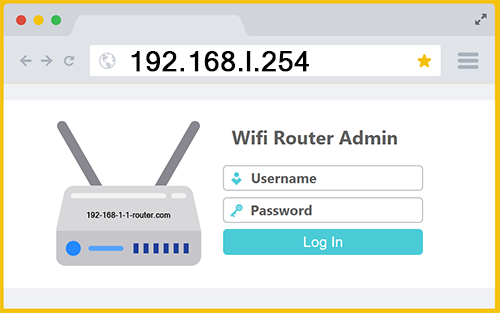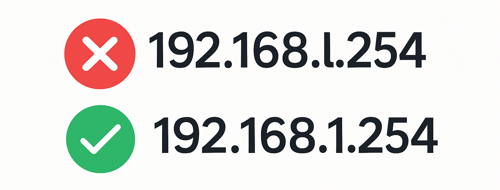192.168.l.254
 Guide to 192.168.l.254 Admin Login
Guide to 192.168.l.254 Admin Login
The IP address 192.168.1.254 is commonly set as the default gateway for accessing the WiFi admin console. This private IP allows an individual, such as yourself, to log into a router’s configuration interface. Once logged in, you can make various adjustments, including changing your WiFi network’s name and password. This is an essential step for personalizing and securing your home network to your specific preferences and needs.
How to Enter 192.168.l.254 Admin

The IP address 192.168.l.254 will not allow you to access your home router. This is because it is not a legitimate IP address! Visiting http://192.168.l.254 or https://192.168.l.254 will never direct you to your Wi-Fi router’s admin panel, as both are invalid URLs. To reach your home Wi-Fi router, you should either click the blue button below or accurately type “192.168.1.254” into your web browser’s address bar.
Most likely username: admin
Most likely password: admin or password
Typically, the admin panel of your family’s network router is accessible from any device connected to the network. This includes a range of devices such as smartphones (both iOS and Android), tablets (like iPads), and computers (whether they are desktops or laptops). This being said, a frequent mistake made by users trying to manage their home network settings is entering an incorrect IP address like 192.168.l.254. When you type the wrong IP address, you won’t reach the router’s login page.
192.168.1.254 vs. 192.168.l.254
When attempting to log into your Internet router, it is crucial to use the precise IP address, which is likely 192.168.1.254. Many individuals mistakenly enter 192.168.l.254, an error that can prevent a successful log in as it’s a typographical misstep. Specifically, the error lies in the third octet of the address which should be the number 1, not the letter l. This seemingly minor detail can cause significant connectivity issues, as IP addresses must consist exclusively of numerals. To ensure a smooth connection to your WiFi router, carefully replace the letter “l” with the numeral “1”. This adjustment will redirect your attempt to the correct local address of your router’s login panel, instead of leading to an invalid IP address.
When entering the IP address into your browser, it’s important to omit the “www” prefix. The common habit of typing “www” before web addresses is suitable when accessing global websites, but inappropriate for local network devices. If you try to visit www.192.168.l.254 your browser will search the World Wide Web instead of trying to locate a local router. In some cases, this will lead to an error message or a failure to load the page, but more often it will result in a weird Google search since your browser will think what you typed is a search query instead of an IP or domain name.
Internet Providers Using 192.168.1.254
Many of the best Internet Service Providers (ISPs) on earth use routers with a default admin IP address of 192.168.1.254. This list includes: AT&T, Telmex, British Telecom (BT), Telus, TPG, Spark, Maxis, Singtel, FASTGate, and Eir.
Router Brands Using This Default
There are many home and office routers that use 192.168.l.254 as the default IP address for their admin login interface. Here are some examples:
- 2Wire
- Aztech
- Billion
- D-Link
- Gigabyte
- Hawking
- Linksys
- Motorola
- MSI
- Netopia
- Planet
- Siemens
- Sitecom
- SpeedTouch
- Trendnet
- Zoom
- Zyxel
Some of these router manufacturers also use other default IP address such as 192.168.l.l (192.168.1.1) and 192.168.O.1 (192.168.0.1). If you are having trouble figuring our what IP address you should be visiting, a Google search can often find the default IP assigned to your router model. If you have the correct address but the 192.168 l 254 login password is not working, it may have been previously changed and you might need to hard reset your router to restore factory defaults.
What is 192.168.l.254?
In order to gain access to your family’s Wi-Fi router, you need to tell your phone or computer how to find it so you can log in as admin. This involves typing in the router’s private IP address. 192.168.l.254 is the default IP address for many network routers. On the Internet, we usually don’t search for IPs, we instead search for a domain such as website name dot com. When exploring devices on your local network, however, a private IP address is the method used to connect to a specific device.
The existence of private IP addresses, such as 192.168.l.254, and the reason why some online destinations lack public addresses is deeply rooted in the structure of Internet Protocol version 4 (IPv4). IPv4 is designed to allocate IP addresses as 32-bit numbers. Given this bit limitation, the total number of possible addresses it can generate is 4,294,967,296. While this figure might seem vast at first glance, it is insufficient given the current demands of global digital connectivity.
The Internet Engineering Task Force (IETF), a key body responsible for the technical standards that govern the Internet, has instructed the Internet Assigned Numbers Authority (IANA) to set aside approximately 17.9 million of these addresses for private use. These private addresses are predominantly utilized within local area networks (LANs) across various settings, including residential, office, and larger corporate environments. For example: 192.168.l.254 is popular for home network routers. The allocation of these private addresses is critical for facilitating internal communications without using the public IP space.
Initially, one might assume that the available pool of nearly 4.3 billion IP addresses would suffice for global needs. However, this assumption falls short when considering the explosive growth of Internet-connected devices, or “smart devices”, which now tally around 23 billion and are projected to double every few years going forward. While your Wi-Fi router might use 192-168-l-254, your smart TV or smart fridge will also need one. To manage this disparity between available addresses and global demand, techniques such as Network Address Translation (NAT) are employed. NAT allows for the extension of a single public IP address to cover an entire network of private IP addresses, effectively enabling multiple devices to share a single address for Internet connectivity.
To address the limitations inherent in IPv4, a newer protocol, Internet Protocol version 6 (IPv6), has been developed. IPv6 operates with a 128-bit address system, exponentially increasing the number of possible addresses to approximately 3.4×10^38. This immense capacity makes it feasible to assign a distinct IPv6 address to every atom on the planet, ensuring that the address space will not be exhausted in the foreseeable future and marking a significant advancement in addressing the global demand for network connections. This transition to IPv6 is crucial as we continue to integrate more devices into the Internet ecosystem, emphasizing the need for a more robust and scalable networking infrastructure.

https://192.168.l.254 Settings
The IP address 192.168.1.254 represents just one example of a private IP address utilized within network environments. Routers typically use this address to establish a unique identity on a local network. If you possess a router configured with 192.168.l.254 as default, accessing the administrative settings should be straightforward provided you have the necessary login credentials.
To modify the settings of your router using this IP address, simply enter 192.168.1.254 (don’t confuse this with 192 168.l.254) into the URL bar of your preferred web browser. I recommend Google Chrome. Once you’ve logged in using the correct username and password, you’ll be able to navigate through the router’s admin site. This interface grants you the ability to make comprehensive changes to the network configuration. Please note: the “http” portion is optional. If you type 192.168.l.254 it should be interpreted the exact same as https://192.168.l.254.
When inputting an IP into a web browser, zero formatting mistakes can be made without causing failure. For example: if you type 192.168.l254 or 192168.l.254 the browser will think you’re searching a phrase not trying to log into a local router. Other common mistakes, such as 192168l254 or 192.168l254, will also prevent you from reaching the admin login panel. When writing the IP, don’t exchange periods with spaces… if you input “192 168 l 254” it will not be understood as an IP address by Chrome or other browsers.
Additional Mistypes
192.168.l00.254 – This is a popular search term according to Google, which suggests many people are inputting this IP address into their browser instead of 192.168.1.254
192.168.l0.254 – This is also a high volume search term for people trying to gain admin access to their WiFi router.
192.168.l.254.1 – Not only should the lowercase “L” be switched to the number “1”, but the final dot one should also be removed.
168.192.l.254 – The first two sections are in reverse order.
See the Difference

Default Password
The default password for 192.168.l.254 routers is usually “admin” or “password”. The default username for 192.168.l.254 routers is almost always “admin”. In some cases, the password can be left blank.
Once you have logged in as admin, you can make adjustments to the router’s settings such as changing the Wi-Fi password or network name. You can also change advanced settings such as network security configurations, parental controls, and can even set up guest networks. Each setting offers the potential to enhance the network’s functionality and security according to your specific needs. Understanding and managing these settings via 192.168.l.254 admin login is crucial for maintaining an optimal home or office network environment. This direct approach to network management not only simplifies the process of making adjustments but also empowers users to take full control of their Internet connectivity.